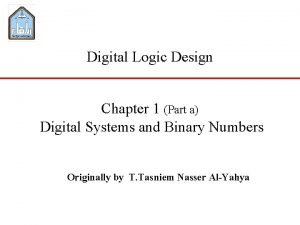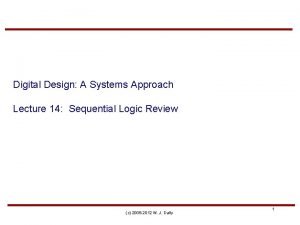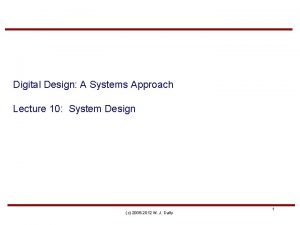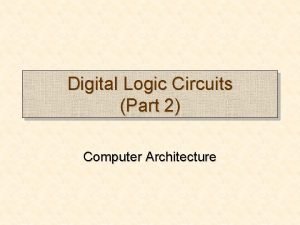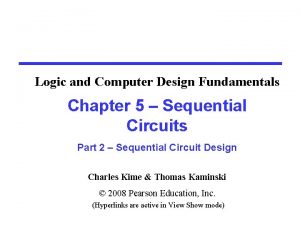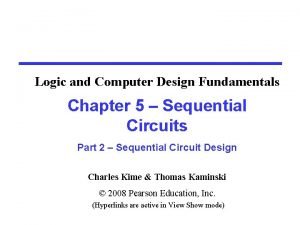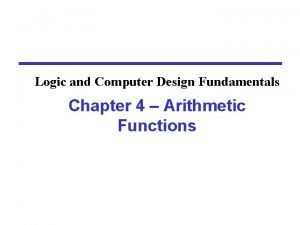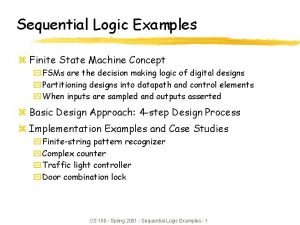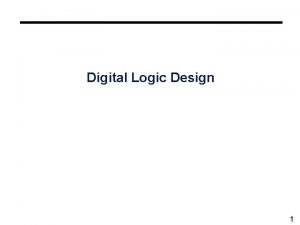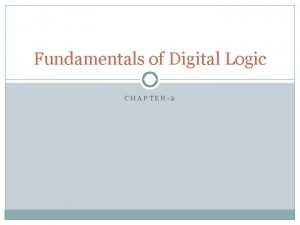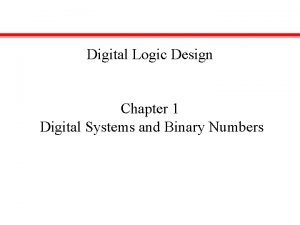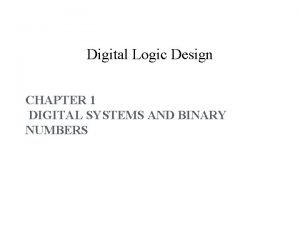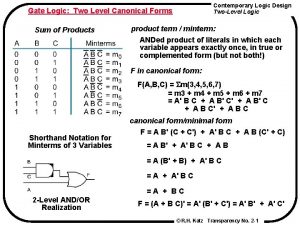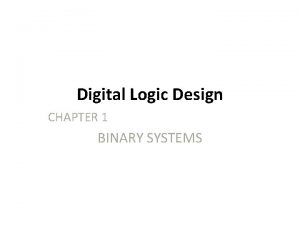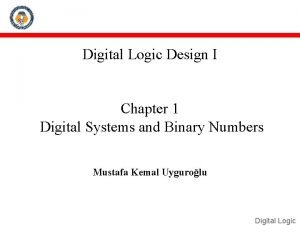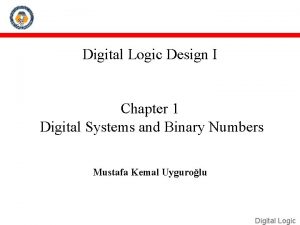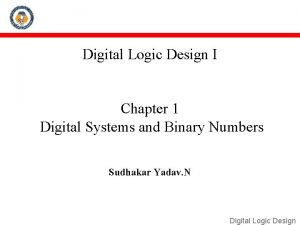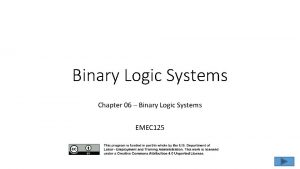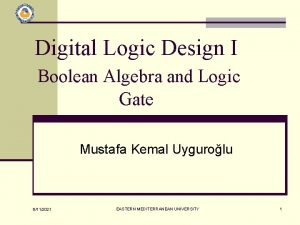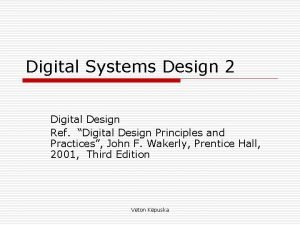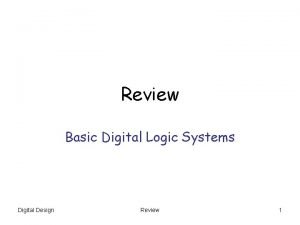Digital Logic Design Chapter 3 Digital Systems and































- Slides: 31

Digital Logic Design Chapter 3 Digital Systems and Binary Numbers Al-Mustansiriyah University College of Science Computer Department Dr. Ghassan M. Al-Saddi

Outline of Chapter 3 © 3. 1 Simplification of Boolean Functions © 3. 2 Product of Sum simplification © 3. 3 Don’t- Care Condition

Another method of simplification of Boolean function is Karnaugh – Map (K-Map). This map is a diagram made of squares, each square represent one minterms, and there are several types of K-|Map depending on the number of variables in Boolean function.

Two-Variable Map A two-variable map u Four minterms u x' = row 0 u x = row 1 u y' = column 0 u y = column 1 u A truth table in square diagram u Fig. (a) xy = m 3 u Fig. (b) x+y = x'y+xy' +xy = m 1+ m 2+m 3

A Three-variable Map u Eight minterms u Any two adjacent squares in the map differ by only on variable q q q e. g. , m 5 and m 7 can be simplified m 5+ m 7 = xy'z + xyz = xz (y'+y) = xz m 0 and m 2 (m 4 and m 6) are adjacent m 0+ m 2 = x'y'z' + x'yz' = x'z' (y'+y) = x'z' m 4+ m 6 = xy'z' + xyz' = xz' (y'+y) = xz'

Ex Simplify the Boolean function F(x, y, z) = S(2, 3, 4, 5) F(x, y, z) = Σ(2, 3, 4, 5) = x'y + xy'

Ex Simplify F(x, y, z) = S (3, 4, 6, 7) F(x, y, z) = S(3, 4, 6, 7) = yz+ xz'

Four adjacent Squares Consider four adjacent squares um 0+m 2+m 4+m 6= x'y'z'+x'yz'+xy'z'+xyz' =x'z'(y'+y) +xz'(y'+y)= x'z' + xz‘= z' um 1+m 3+m 5+m 7 = x'y'z+x'yz+xy'z+xyz =x'z(y'+y) + xz(y'+y) =x'z + xz = z

Ex Simplify F(x, y, z) = S(0, 2, 4, 5, 6) = z'+ xy'

Ex let F = A'C + A'B + AB'C + BC a) Express it in sum of minterms. b) Find the minimal sum of products expression F(A, B, C) = S(1, 2, 3, 5, 7) = C + A'B A'C + A'B + AB'C + BC = C + A'B

Four-Variable Map © The map u u 16 minterms Combinations of 2, 4, 8, and 16 adjacent squares

Adjacent Squares

n Ex Simplify F(w, x, y, z) = S(0, 1, 2, 4, 5, 6, 8, 9, 12, 13, 14) F(w, x, y, z) = Σ(0, 1, 2, 4, 5, 6, 8, 9, 12, 13, 14) = y' + w' z' +xz'

n Ex Simplify F = A B C + B CD + A B C D + AB C = B D + B C +A CD

Five-Variable Map © Map for more than four variables becomes complicated u Five-variable map: two four-variable map (one on the top of the other).

© Or the map is like this

Ex Simplify F = S(0, 2, 4, 6, 9, 13, 21, 23, 25, 29, 31) F = A'B'E'+BD'E+ACE

Ex Simply the following Boolean functions using K –Map? 1 - F = X Y Z + X Y Z F = X Y + X Y 2 - F = X Y Z + X Y Z F = Y Z + X Z 3 - F = A C + A B C + B C F = C + A B 4 - F ( X, Y, Z ) = Σ ( 0, 2, 4 , 5 , 6 ) F ( X, Y, Z ) = Z + X Y 5 - F ( X, Y, Z, W ) = Σ ( 0, 1, 2, 4, 5, 6, 8 , 9 , 12, 13, 14 ) F ( X, Y, Z, W ) = Z + X W + Y W 6 - F = A B C + B C D + A B C F ( A, B, C, D ) = B D + B C + A C D

H. W Simplify the following functions in sum of product using Kmap 1 - F = X Y + X Y W + W ( X Y + X Y ) 2 - F = A B D + A C D + A B D 3 - F ( A, B , C, D ) = Π ( 2, 3, 6, 7, 8, 9, 10 , 11, 12, 13, 14 )

Product of Sum simplification In previous examples the simplification in Sum of Product form and each minterms represented by 1 (one) in K-map and each missing term in the function is a complement of the function and represented by 0 (zero) in k-map and the simplified expression obtained F (the complement of the function).

Sum-of-Minterm Procedure n Consider the function defined in Table; q In sum-of-minterm: q In sum-of-maxterm: q Taking the complement of F

Ex Simplify F = S (0, 1, 2, 5, 8, 9, 10) into 1 - sum-of-products form. 2 - product-of-sums form Sol : 1 – Sum of Products (minterms) a) F(A, B, C, D)= S(0, 1, 2, 5, 8, 9, 10) = B'D'+B'C'+A'C'D b) F' = AB+CD+BD' Apply De. Morgan's theorem; F=(A'+B')(C'+D')(B'+D)

n Gate implementation of the function of Example Sum-of products form Product-of sums form

Ex Obtained the simplified expression in Product of Sums F = ( A' + B' + D ) ( A' + D' ) ( A + B' + C + D ) F' = A B D' + A D + A' B' D + A' B C' D' CD AB 00 01 11 10 00 01 0 0 11 0 0 10 0 F' = A B + B' D + B C' D' F = ( A' + B' ) ( B + D' ) ( B' + C + D )

Ex Obtained the simplified expression in Product of Sums F ( A, B, C, D ) = Π ( 0, 1, 2, 3, 4, 10, 11) CD AB 00 00 01 0 10 01 11 0 0 10 0 F' = A' B' + A' C' D' + B' C F = ( A + B ) ( A + C + D ) ( B + C' )

H. W : Obtained the simplified expression of the following functions in 1 - Sum of Products 2 - Product of Sums 1 - F = X' Y' + Y' Z' + Y Z' + X Y Z 2 - F ( X, Y, Z, W) = Π ( 1, 3 , 5, 7, 13, 15 ) 3 - F = ( A + B' + D ) ( A' + B + D) ( C + D ) ( C' + D' )

Don't-Care Conditions © The “Don’t Care” conditions allow to replace the empty cell of a K-Map to form a grouping of the variables. © While forming groups of cells, we can consider a “Don’t Care” cell as either 1 or 0 or we can simply ignore that cell. © Therefore, “Don’t Care” condition can help to form a larger group of cells. © A Don’t Care cell can be represented by a cross(X) in K-Maps representing a invalid combination. © These values used in simplification with F and F'.

Ex Simplify the Boolean function F in 1 - Sum of Products (S. O. P) 2 - Product of Sums (P. O. S) F( X, Y, Z, W)=Σ(1, 3, 7, 11, 15 ) d(X, Y, Z, W )=Σ (0, 2 , 5 ) Sol 1 - Sum of Products CD AB 00 00 X 01 11 10 1 1 X X 1 1 1 F ( X, Y, Z, W) = Z W + X' Y' 2 – Product of Sums CD AB 00 00 X 01 0 10 0 01 11 10 X X 0 0 0 F ( X, Y, Z, W) = W' + X Z' F ( X, Y, Z, W) = W ( X' + Z )

Ex Simplify the Boolean function F in 1 - Sum of Products 2 - Product of Sums using don’t care condition F = A C E + A' C D' E' + A' C' D E D = D E' + A' D' E + A D' E' Sol F = A C E. 1 + A C D E = A C D E + A C D' E + A' C D' E' + A' C' D E D = D E' ( A + A' ) + A' D' E ( C + C' ) + A D' E' ( C + C' ) = A D E' ( C + C' ) + A' C D' E + A' C' D' E + A C D' E' + A C' D' E' = A C D E' + A C' D E' + A' C D' E + A' C' D' E +A C D' E' + A C' D' E'

1 - Sum of Products DE AC 00 00 01 1 11 X 10 X 01 11 10 X 1 X 1 X X S. O. P F ( A, C, D, E ) = A C + C E' + A' C' D 2 – Product of Sums DE AC 00 00 0 01 11 X 10 X 01 11 X X 10 X X 0 0 X P. O. S. F'( A, C, D, E )= A C' + C' D' + A' C D F ( A, C, D, E ) = (A' + C ) (C + D ) ( A + C ' + D' )

H. W. Simplify the Boolean function F in Sum of Products using don’t care condition F = B' C' D' + B C D' + A B C' D D = B' C D' + A' B C' D'
 Digital logic design tutorial
Digital logic design tutorial Digital system design
Digital system design Digital logic design practice problems
Digital logic design practice problems Digital logic design lectures
Digital logic design lectures Digital logic design
Digital logic design Digital systems testing and testable design
Digital systems testing and testable design First order logic vs propositional logic
First order logic vs propositional logic First order logic vs propositional logic
First order logic vs propositional logic Third order logic
Third order logic Concurrent vs sequential
Concurrent vs sequential Tw
Tw Software project wbs example
Software project wbs example Combinational logic sequential logic
Combinational logic sequential logic Combinational logic sequential logic 차이
Combinational logic sequential logic 차이 If x = 0 and y = 1, which output line is enabled?
If x = 0 and y = 1, which output line is enabled? 2057 octal to decimal
2057 octal to decimal Binary systems and logic circuits
Binary systems and logic circuits Digital design: a systems approach
Digital design: a systems approach Digital design a system approach
Digital design a system approach Digital system design using verilog
Digital system design using verilog Digital logic and computer architecture
Digital logic and computer architecture Jk flip flop
Jk flip flop Logic and computer design fundamentals
Logic and computer design fundamentals 010000112
010000112 Logic and computer design fundamentals
Logic and computer design fundamentals Fsm design examples
Fsm design examples Gate delays and timing diagrams
Gate delays and timing diagrams Plc mixer process control problem
Plc mixer process control problem Canonical form digital logic
Canonical form digital logic Logic gates identities
Logic gates identities Digital logic structures
Digital logic structures Boolean algebra simplification
Boolean algebra simplification

